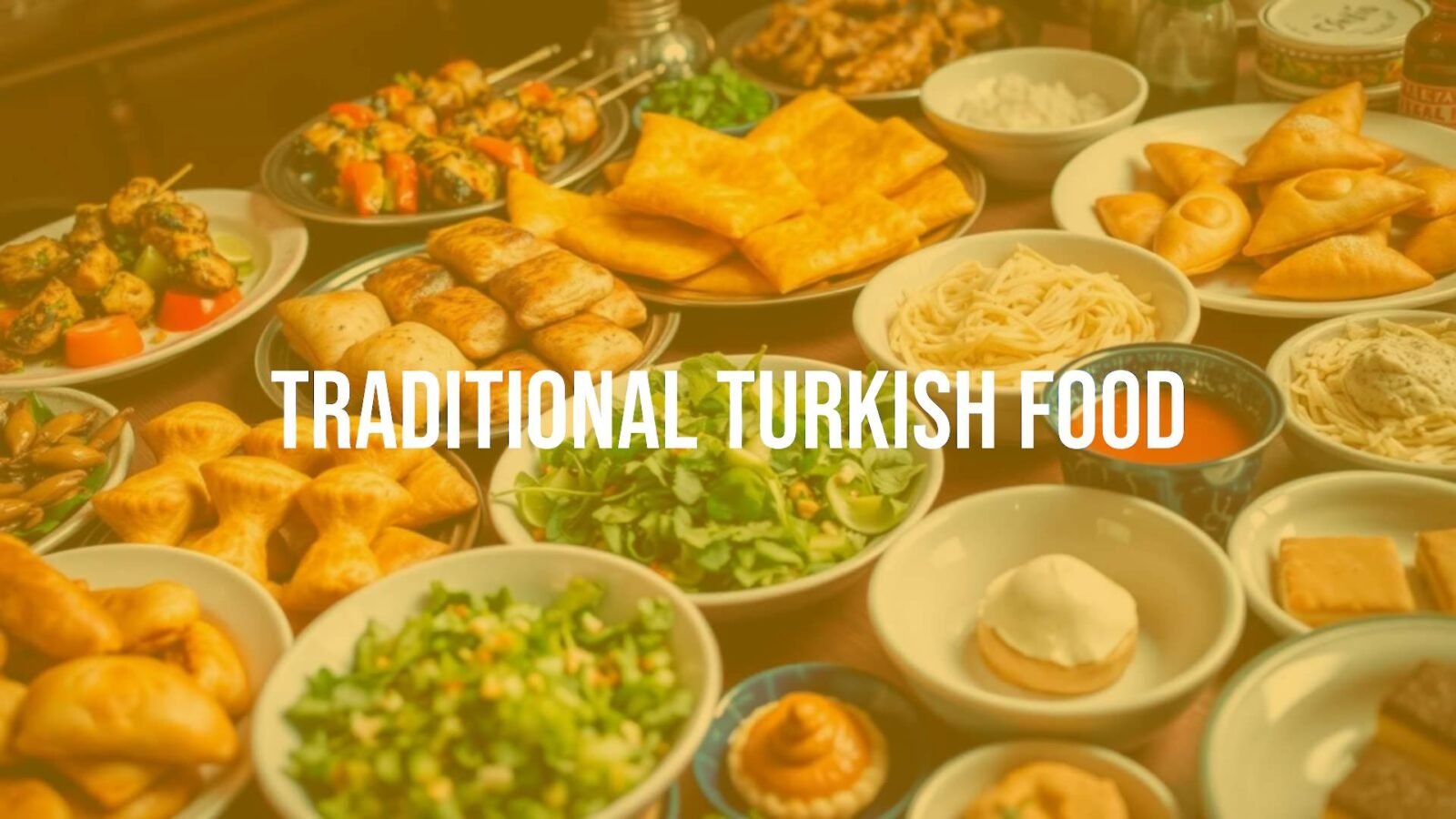Traditional Turkish food is colorful and full of history, shaped by different regions and many cultural influences. Turkey is famous for its kebabs, but the cuisine goes far beyond that. You’ll find filling stews, flaky pastries, fresh salads, and interesting desserts. Turkish recipes bring together simple, top-quality ingredients, and cooks use them with care to create unforgettable meals.

What Is Traditional Turkish Food?
Traditional Turkish food has grown from a long history, different climates, and local customs. Each dish tells part of Turkey’s story, showing how people, land, and outside cultures have come together in the kitchen.
Main Ingredients and Staples
Turkish food is built on fresh, seasonal ingredients. Grains like wheat and rice, plus lots of vegetables, are at the heart of many recipes. Bulgur (cracked wheat) is very common, sometimes used instead of rice. Olive oil, especially in the west, adds flavor to vegetables and salads. Fresh herbs-such as mint, dill, and parsley-are always used, while spices like sumac, cumin, and red pepper flakes bring extra taste without making food too spicy.
People eat a lot of lamb, beef, and chicken, usually grilled or in stews, but vegetables and vegetarian options are also very important. Yogurt and different cheeses are used in sauces and side dishes, adding a creamy and tangy taste. Legumes such as lentils, chickpeas, and beans are found in many everyday meals.
Regional and Neighboring Food Influences
Turkish cuisine is deeply influenced by the Ottoman Empire and neighboring regions like Central Asia, the Middle East, the Mediterranean, the Balkans, and Eastern Europe. Each region in Turkey has its own favorites. For example, the Aegean and Mediterranean sides feature olive oil dishes and seafood, while Central Anatolia is known for filling stews and homemade pastas, such as manti. Down in the southeast-areas like Gaziantep and Adana-you’ll find spicy kebabs and sweet desserts like baklava and künefe. In the Black Sea region, fish (especially anchovies) and corn-based dishes are popular. Every region adds something unique to the country’s food.

Cultural Traditions and Eating Habits
In Turkey, sharing food is an important way to show hospitality and connect with others. Meals often bring families and friends together. Even simple meals like a Turkish breakfast or sharing tea are important parts of daily life and highlight how eating is a social experience here. There are songs about food, which shows how deeply it is loved.
What Are the Core Ingredients in Turkish Cuisine?
Turkish dishes taste special thanks to the use of local, fresh ingredients, many of which are grown or made in Turkey’s rich countryside.
Table: Common Foods in Turkish Cooking
| Ingredient | Examples in Dishes |
|---|---|
| Grains | Bulgur, rice, bread varieties (bazlama, pide, simit, yufka) |
| Pulses | Lentils, chickpeas, beans (mercimek çorbası, kuru fasulye) |
| Meat | Lamb, beef, chicken (kebabs, köfte, stews) |
| Seafood | Anchovy (hamsi), sardine, bonito, mussels |
| Dairy | Yogurt, beyaz peynir, kaşar cheese, ayran drink |
| Vegetables | Eggplant, tomato, green pepper, zucchini, beans |
| Herbs & Spices | Mint, parsley, dill, cumin, sumac, red pepper flakes |
| Fruits & Nuts | Apricot, plum, fig, pomegranate, pistachio, walnut, hazelnut |
| Oils & Fats | Olive oil, butter, sunflower oil, lamb fat (kuyruk yağı) |
How Do Turkish People Eat Together?
Eating is a special time in Turkey, all about bringing people together, and showing care through shared meals.
Breakfast (Kahvaltı)
Kahvaltı, the Turkish breakfast, is loved by everyone in Turkey. It means “before coffee” and is usually a big meal with different cheeses (beyaz peynir, kaşar), tomatoes, cucumbers, black and green olives, butter, jams, honey, and kaymak (clotted cream). Eggs are common, either scrambled with vegetables (menemen) or poached in yogurt (çılbır). Sucuk (spicy sausage) or pastırma (cured beef) might be served too. Several types of bread, like simit and börek, are a must. Strong Turkish tea, served in small glasses, is always present.

Lunch and Dinner
Lunch and dinner often feature a main hot dish with pilaf, bread, salad, or cacık (yogurt with cucumber). Lighter meals are common in summer, such as cold olive oil dishes or cheese with fruit. Many people eat homemade meals, but there are also affordable local restaurants (esnaf lokantası) serving simple, traditional food. Dinner is usually late (7-9 p.m.) and relaxed, with main courses like stews and grills. Appetizer plates (meze) may be shared before the main course, and dessert with tea or coffee can stretch the meal into the evening.
Eating Together: The Meze Table
Meze are small dishes served before or with a meal and are meant to be shared. Typical mezes include hummus, ezme (spicy tomato and walnut dip), haydari (thick yogurt dip), eggplant salads, stuffed grape leaves (yaprak sarma), and cheeses. Everyone takes a little of everything, making meals relaxed and social.
What Are the Best-Known Turkish Dishes?
Turkish food offers many well-loved dishes, each with its own story and flavor.
Kebabs
- Döner Kebab: Thin layers of meat cooked on a vertical spit, found everywhere.
- Adana Kebab: Spicy ground lamb on a skewer, from Adana.
- Urfa Kebab: Similar to Adana but less spicy.
- Şiş Kebab: Marinated meat cubes grilled on skewers.
- İskender Kebab: Thin sliced döner on pita bread, topped with tomato sauce, butter, and yogurt.
- Testi Kebab: Meat and vegetables cooked in a sealed clay pot, broken open at the table.

Köfte (Meatballs)
- İnegöl Köfte: Grilled beef or lamb meatballs.
- Kadınbudu Köfte: Minced meat mixed with rice and fried.
- Mercimek Köfte: Lentil and bulgur patties-no meat.
Manti (Dumplings)
Turkish dumplings, especially from Kayseri, are small parcels of pasta filled with meat, served with garlic yogurt and melted butter with red pepper. There are also vegetarian versions.
Lahmacun and Pide (Flatbreads)
- Lahmacun: Thin, crispy bread topped with minced meat, tomato, and herbs. Often called “Turkish pizza.”
- Pide: Boat-shaped bread with fillings like meat, cheese, or spinach, baked in a wood-fired oven.

Stuffed Foods (Dolma, Sarma, Imam Bayıldı)
- Dolma: Vegetables like peppers or eggplants stuffed with herbed rice or meat.
- Sarma: Rice and herbs (or meat) wrapped in grape or cabbage leaves.
- İmam Bayıldı: Eggplant filled with onions and tomatoes, cooked in olive oil. Vegan; the meat version is called karnıyarık.
Soups and Stews
- Mercimek Çorbası: Red lentil soup.
- Ezogelin Çorbası: Spiced red lentil soup with tomato and mint.
- Güveç: Mixed meat/vegetable stew.
- Etli Taze Fasulye: Green bean and meat stew.
Meze Dishes
- Piyaz: Bean salad with onion and parsley.
- Arnavut Ciğeri: Fried liver with sumac and onion.
- Kısır: Bulgur salad with herbs and tomato.
- Şakşuka: Fried eggplant and vegetables with sauce or yogurt.
- Sigara Böreği: Fried cheese-filled rolls.
Vegetarian/Vegan Choices
Many Turkish dishes, especially meze and olive oil-cooked vegetables (zeytinyağlılar), are naturally vegetarian or vegan. These include stuffed peppers, eggplant dishes, lentil soup, bean stews, and salads.
Turkish Street Food and Regional Specialties
Street food is everywhere in Turkey, offering tasty snacks at any time and reflecting local traditions.
Popular Street Foods
- Simit: Sesame-coated bread ring, like a bagel, easy to eat on the go.
- Börek: Savory pastry with spinach, cheese, or meat, made from thin yufka dough.
- Gözleme: Filled flatbread (cheese, spinach, or meat), cooked on a hot plate.
Seafood Snacks
- Balık Ekmek: Fish sandwich with fried or grilled fish, lettuce, and onions served in bread-popular in coastal areas.
- Midye Dolma: Stuffed mussels with spiced rice.
Regional Favorites
Some popular foods are found all over Turkey, but others are known mainly in certain areas. For example, Cağ Kebab (lamb on a spit) is famous in Erzurum, Black Sea regions love anchovy dishes (like hamsili pilav), and Central Anatolia is known for wheat stews and different pasta. Turkey’s regions make street food interesting and diverse wherever you go.
Traditional Turkish Desserts
Turkish sweets range from layered pastries soaked in syrup to thick puddings and special ice creams.
Baklava and Syrupy Sweets
- Baklava: Thin layers of filo dough with nuts (often pistachios), soaked in syrup. Gaziantep is famous for its baklava.
- Şekerpare: Soft semolina cookies in syrup.
- Revani: Semolina cake in syrup.

Other Famous Desserts
- Künefe: Shredded pastry baked with cheese, soaked in syrup, served warm with nuts.
- Kadayıf: Shredded filo, sometimes with nuts and syrup.
- Helva: Dense sweet treat, can be flour, semolina, or tahini-based. Common at special times or for guests.
Lokum (Turkish Delight) and Special Treats
- Lokum: Soft jelly cubes in many flavors (rose, lemon, pistachio), coated in powdered sugar or nuts.
- Cezerye: Sweet made with carrot and nuts.
- Cevizli Sucuk: Walnuts dipped in grape molasses and dried.
Dondurma (Turkish Ice Cream) and Puddings
- Dondurma: Stretchy, chewy ice cream that doesn’t melt easily. Made thick with orchid root flour (sahlep) and mastic.
- Ekmek Kadayıfı: Syrup-soaked bread pudding, often served with cream.
- Milk Puddings: Includes muhallebi (rice pudding), kazandibi (with caramelized bottom), and tavuk göğsü (contains shredded chicken).
Drinks That Go With Turkish Food
Drinks play an important part in Turkish meals, whether it’s tea with breakfast or a yogurt drink with kebabs.
Tea and Coffee
- Turkish Tea (Çay): Strong black tea served in tulip-shaped glasses, always without milk.
- Turkish Coffee: Thick, unfiltered coffee served in a small cup, often with the grounds used for fortune-telling.
Ayran and Soft Drinks
- Ayran: Yogurt, water, and salt combined for a refreshing and cooling drink, often with spicy or grilled foods.
- Şalgam Suyu: Fermented black carrot juice, sometimes spicy, pairs well with kebab.
- Boza: Traditional, thick drink made from fermented millet, topped with cinnamon and roasted chickpeas.
- Sahlep: Hot, creamy milk drink with orchid flour, sweet, usually enjoyed in winter.
- Limonata: Homemade lemonade, common with sweets.
- Şerbet: Sweet, cold drink flavored with fruit, flowers, or herbs.
Alcohol in Turkey
- Rakı: Anise-flavored spirit, turns milky-white with water, typically shared with meze and seafood.
- Wine: Turkey produces varieties from its own grapes, especially in Cappadocia and Aegean regions.
- Beer: Efes is the most popular lager; local craft beers are becoming more common.
Why Is Turkish Food Special?
Appeal for Travelers
Visitors are often amazed by the range of food in Turkey. There is constantly something new to try, with dishes for all tastes, and most food is rich in flavor but not very spicy. Turkish eating is also about spending time together, sharing food, and making memories-whether it’s a busy market, a street vendor’s stand, or a family dinner.
Comparing Turkish and Mediterranean Food
Turkish cuisine shares ingredients and dishes with Greek, Middle Eastern, and Mediterranean kitchens-like olive oil, vegetables, and flatbreads-but it has its own character. Spices are usually mild, yogurt is used everywhere (in meals and drinks), and slow-cooked dishes and special techniques, such as cooking in clay pots, are common. Turkish food has taken many outside ideas and made them truly Turkish in taste and style.
Frequently Asked Questions about Traditional Turkish Food
Is Turkish food spicy?
Not very. Most Turkish dishes have rich flavors without being hot. Some places, like Adana or Gaziantep, add more chili, but overall the food is mild. Cooling yogurt sauces or salads are often served to balance the heat if any.
Is Turkish food halal?
Yes, most traditional Turkish recipes use halal meat, and pork is not usually eaten. Restaurants across Turkey serve halal meals, making it easy for Muslim travelers to find suitable food.
What foods are unique to Turkish cuisine?
Dondurma (chewy ice cream), Kayseri-style manti, testi kebab cooked in a clay pot, the heavy use of yogurt in both food and drinks, and different shapes and fillings of börek and pide are just some of the unique features of Turkish cooking.
Is Turkish cuisine vegetarian-friendly?
Definitely. Many mezes, olive oil vegetable dishes, lentil soups, bean stews, and salads are vegetarian or vegan. Stuffed peppers, zucchini, or eggplant (dolma), and Imam Bayıldı are top choices for plant-based eaters.
Can people with dietary restrictions enjoy Turkish food?
Yes. Many dishes are naturally gluten-free (like kebabs with rice, lentil soup, and salads). Dairy-free eaters should watch out for yogurt, but most olive oil dishes and salads are fine. The variety and focus on fresh ingredients make it easy to find something suitable for most diets.














Leave a comment